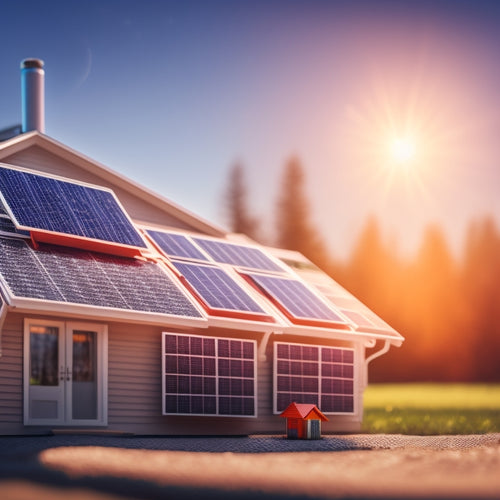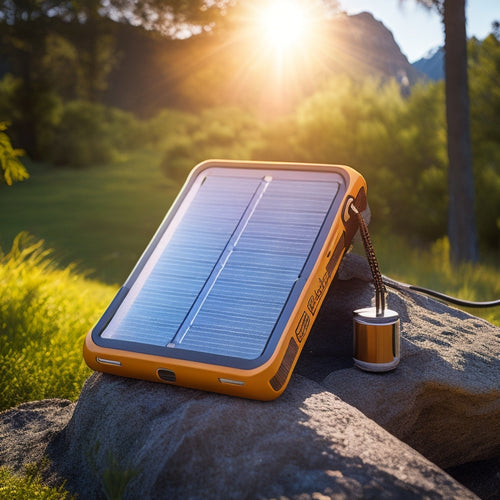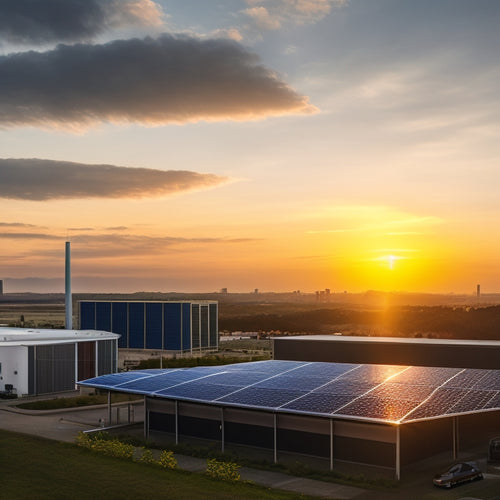
What's in a Solar Panel Cleaning Checklist?
Share
Your solar panel cleaning checklist should include regular inspections to identify dirt accumulation, customized cleaning schedules based on environmental factors, and effective cleaning methods like soft brushes and microfiber cloths to enhance energy output by up to 15%. You'll also want to evaluate debris removal frequency, ensuring daily checks for leaves, twigs, and bird droppings, and verify your panel angle tilt to maximize energy absorption. Finally, factor in seasonal variations, like increased dust in summer and natural cleansing from spring and fall rains, to optimize your cleaning routine and minimize energy losses - and that's just the beginning of what you need to know.
At a Glance
- Inspect panels regularly to identify dirt accumulation and debris, including leaves, twigs, and bird droppings, to maintain peak efficiency.
- Clean panels using soft brushes and microfiber cloths, and avoid harsh chemicals that can damage the panels.
- Establish a customized cleaning schedule based on environmental factors, including pollution levels, local climate, and seasonal changes.
- Verify panel angles to ensure optimal energy production, with a tolerance of 2-3 degrees from the recommended angle.
- Utilize monitoring systems to track solar panel performance and energy output, and adjust cleaning frequency accordingly.
Boosts Energy Output 15%
You'll be surprised to learn that a clean solar panel can increase energy output by up to 15%. This significant enhancement is attributed to the removal of dirt, grime, and other obstructions that impede sunlight from reaching photovoltaic cells.
In fact, many shoppers struggle to find a reliable and trustworthy solar installation service provider that can guarantee quality workmanship and long-term system efficiency, which is essential for maximizing energy output reliable solar installation.
Cleanliness Matters Most
By installing solar panels, homeowners and businesses alike expect an increase in renewable energy production, but dirt and grime can greatly diminish this output. You invest in solar panels to reduce your carbon footprint and generate clean energy, but neglecting panel maintenance can undermine your efforts.
In fact, by switching to Residential Solar Power, you can guarantee a reliable source of energy and reduce your reliance on the grid. Additionally, with a Home Solar Power Generator, you can utilize renewable energy and minimize your carbon footprint. Dirty panels can reduce energy output by up to 15%, which translates to lost savings and a lower return on investment.
To maximize your solar panel's energy output, you need to prioritize cleanliness. Develop a regular cleaning schedule to remove dirt, dust, and debris that accumulate on the panels. Effective cleaning techniques involve using a soft-bristled brush or a microfiber cloth to gently remove loose particles.
Avoid using harsh chemicals or abrasive materials that can scratch the panels and compromise their performance. Regular cleaning not only enhances energy output but also extends the lifespan of your solar panels.
Maximize Solar Efficiency
Maximizing solar efficiency is key to reaping the full benefits of your solar panel investment. You can enhance energy output by 15% by focusing on the right strategies. To maximize efficiency, it is crucial to evaluate various factors, including solar panel materials, maintenance tips, and environmental impact.
| Efficiency Enhancers | Tips and Evaluations |
|---|---|
| Cleaning Techniques | Regular cleaning using soft brushes and mild soap to remove dirt and debris |
| Efficiency Monitoring | Track performance using monitoring systems to identify areas for improvement |
| Weather Considerations | Install panels at an ideal angle and direction to maximize energy absorption |
| Technology Advancements | Stay updated on the latest advancements in solar panel technology to enhance performance |
Reduces Soiling Loss Rate
You're likely aware that soiling loss rate is a significant concern for solar panel performance, and it's directly tied to factors like environmental conditions, panel angle, and maintenance frequency.
In fact, residential solar panels are designed to maximize energy output, but even the most efficient systems can be affected by soiling.
By understanding these soiling rate factors, you can enhance energy output and minimize losses.
Regular cleaning is a vital step in this process, as it helps maintain ideal energy production and reduces the negative impact of soiling on your solar panel system.
Soiling Rate Factors
Identifying the factors that influence soiling rates is essential for reducing soiling loss rates and optimizing solar panel performance. You need to evaluate the soil composition in your area, as it directly affects the soiling rate. For instance, areas with high levels of calcium and magnesium in the soil are more prone to soiling.
Additionally, environmental impact plays a significant role in soiling rates. Proximity to industrial areas, construction sites, or agricultural lands can increase the amount of pollutants and particulate matter in the air, leading to higher soiling rates.
You should also take into account the local climate and weather patterns. Regions with high humidity, frequent rainfall, or strong winds are less likely to experience high soiling rates. On the other hand, areas with low rainfall and high temperatures are more susceptible to soiling.
Understanding these factors will help you develop a more effective cleaning schedule and reduce soiling loss rates. By doing so, you'll be able to maximize your solar panel's energy output and enjoy the freedom that comes with generating your own clean energy.
Optimize Energy Output
Your solar panel's energy output is directly tied to its cleanliness, and even a thin layer of dirt or debris can considerably reduce its performance. A clean solar panel is vital to maximize energy efficiency, as dirt and debris can block sunlight from reaching the photovoltaic cells.
According to the National Renewable Energy Laboratory, dirty solar panels can reduce energy output by up to 25%. Regular cleaning is essential to maintain peak energy output and reduce soiling loss rate.
To enhance energy output, you should prioritize solar maintenance. Regularly inspect your solar panels for signs of dirt, dust, or debris accumulation. Use a soft-bristled brush or a specialized solar panel cleaning tool to remove loose debris.
For more thorough cleaning, use a mild soap solution and water. Avoid using harsh chemicals or abrasive materials that can damage the panels.
Debris Removal Frequency Matters
You'll want to perform daily debris inspections to catch any obstructions before they impact energy production.
By investing in a high-quality solar panel system, such as a photovoltaic system, you can guarantee maximum energy efficiency.
Establishing regular cleaning schedules is also essential to maintaining ideal performance.
Daily Debris Inspection
As solar panels are constantly exposed to the elements, debris accumulation is an ongoing concern that requires regular attention. You can't afford to let dirt, dust, and other obstructions hinder your system's energy output.
Daily debris inspections are essential to identify and remove debris types like leaves, twigs, and bird droppings that can compromise your solar panels' performance. Conducting daily inspections allows you to catch issues before they escalate.
You'll need inspection tools like a soft-bristled brush, a garden hose, and a cleaning solution to remove stubborn debris. Make sure to inspect each panel individually, paying attention to corners and crevices where debris tends to accumulate.
Check for signs of wear and tear, like scratches or cracks, which can further compromise panel efficiency.
Regular Cleaning Schedules
Daily inspections set the stage for a more thorough cleaning schedule.
As you move forward, it's crucial to establish a regular cleaning frequency to guarantee your solar panels operate at peak efficiency. You'll want to take into account factors like climate, location, and panel angle when determining the ideal cleaning schedule.
In general, it's recommended to clean your solar panels every 6-12 months, depending on the level of debris accumulation.
However, if you live in an area with high levels of pollution, dust, or debris, you may need to increase the cleaning frequency. For example, if you're located near a highway or in a dusty region, you may need to clean your panels every 3-6 months.
Inspect Panel Angle Tilt
You'll need to verify that your solar panels are installed at the ideal tilt angle, which is typically calculated based on your location's latitude.
Proper angle verification is essential, as an incorrect tilt can greatly impact energy production.
In fact, a well-designed residential solar power system takes into account the best tilt angle to maximize energy harvesting.
To guarantee best energy harvesting, you should double-check that your panels are aligned to within 2-3 degrees of the recommended angle.
Ideal Tilt Calculation
Typically, solar panels are installed at an angle to maximize energy production, and the ideal tilt calculation guarantees they're positioned for peak performance. As you inspect the panel angle tilt, it's crucial to understand the best angles for your specific location. The ideal tilt calculation takes into account the latitude of your location, the time of year, and the orientation of the panel.
| Latitude | Best Angle (°) | Tilt Adjustments |
|---|---|---|
| 0-23.5 | 15-25 | ±5° |
| 23.6-36.5 | 20-30 | ±5° |
| 36.6-47.5 | 25-35 | ±5° |
| 47.6-56.5 | 30-40 | ±5° |
| 56.6-90 | 35-45 | ±5° |
Proper Angle Verification
Having determined the ideal tilt calculation for your solar panels, it's time to verify that they're installed at the correct angle.
Proper angle verification is vital to guarantee optimal energy output and extend the lifespan of your solar panels. Start by taking an angle measurement using a digital inclinometer or a smartphone app.
Compare the measurement to your ideal tilt calculation to identify any discrepancies. If the installed angle deviates from the calculated ideal, you may need to make tilt adjustments.
Check the panel's mounting system to see if it allows for adjustments. If so, make the necessary changes to achieve the best angle.
Remember to re-take angle measurements after making adjustments to confirm they're accurate. Record the verified angle in your maintenance log to make sure future cleaning and maintenance tasks are performed with the correct angle in mind.
Customized Cleaning Schedules Optimize
You'll want to take into account seasonal cleaning patterns that impact your solar panel's energy output, as they matter considerably in maintaining ideal performance.
For instance, during winter months, snow and ice accumulation may require more frequent cleaning, while summer's dry spell may necessitate more attention to dust and debris.
Seasonal Cleaning Patterns Matter
As solar panels' energy output fluctuates with the changing seasons, adapting your cleaning schedule to these patterns becomes vital for peak performance.
You'll want to take into account the seasonal impacts on your solar panels, as they can greatly affect energy production. During winter, snow and ice can reduce energy output, while summer's heat and humidity can increase dirt accumulation.
To optimize your cleaning schedule, you should include weather considerations, such as increased rain during spring and fall, which can wash away dirt and debris, reducing the need for frequent cleaning.
Conversely, dry and windy seasons can lead to more frequent cleaning needs. By tailoring your cleaning schedule to these seasonal patterns, you'll guarantee your solar panels operate at maximum efficiency, giving you the freedom to utilize the sun's energy to its full potential.
Create a customized cleaning schedule that takes into account these seasonal variations, and you'll be well on your way to maximizing your solar panel's energy output.
Frequently Asked Questions
Can I Clean Solar Panels Myself or Do I Need a Professional?
You can clean solar panels yourself, but make certain you take necessary safety precautions, like wearing gloves and protective eyewear, and use appropriate cleaning tools, such as soft-bristled brushes and deionized water, to avoid damaging the panels.
How Often Should I Clean My Solar Panels to Maximize Energy Output?
You'll want to clean your solar panels every 6-12 months, depending on your location's climate and pollution levels, to maintain peak energy efficiency, as dirty panels can reduce energy output by up to 25%.
What Are the Best Cleaning Solutions for Solar Panels?
Don't worry, you won't harm your panels with harsh chemicals! You'll find eco-friendly solutions, like deionized water and mild soap, work best. Employ gentle cleaning techniques, like soft-bristled brushes and microfiber cloths, to guarantee a sparkling clean surface that maximizes energy output.
Can I Use a Hose to Clean My Solar Panels?
You're wondering if you can use a hose to clean your solar panels? While it's tempting, prioritize hose safety and opt for gentle cleaning tools instead, as high-pressure sprays can damage panels and compromise energy output.
Do Solar Panels Need Cleaning During the Winter Months?
As winter's icy grip tightens, you wonder if solar panels need cleaning during the cold months; yes, they do, as snow accumulation can reduce winter efficiency by up to 50%, so brush off the snow and let the sun shine through.
Explore More
As you wrap up your solar panel cleaning routine, you'll coincide with a staggering 15% increase in energy output. That's not all - regular cleaning reduces soiling loss rates, ensuring your panels perform at their finest. By sticking to a customized cleaning schedule, you'll catch debris before it accumulates, and inspecting panel angles will guarantee peak energy harvesting. It's no coincidence that a thorough cleaning checklist yields significant returns - it's a formula for success.
Related Posts
-

A Beginner's Guide to Navigating the Solar Investment Tax Credit
You're eligible to claim a significant Solar Investment Tax Credit (ITC) of 30% of total installation costs, but mane...
-

Fastest Solar Chargers for Emergency Power
When choosing the fastest solar chargers for emergency power, you need to focus on features like rapid charging capab...
-

Advantages of Commercial Solar Battery On-Site Storage
By investing in a commercial solar battery on-site storage system, you can greatly reduce your energy grid dependence...


